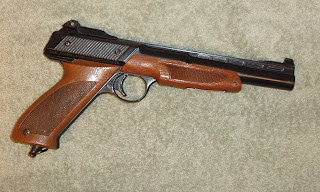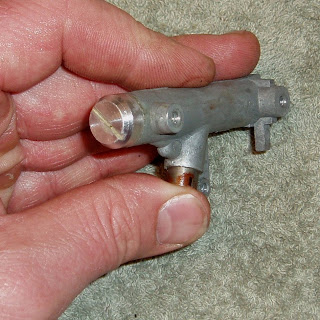Found this Daisy PowerLine 1200 CO2 pistol at the local gun shop for $15. Normally, I wouldn't bother buying a BB gun, but it looked like it was in almost mint condition. And how wrong can you go for $15? I knew I could at least get some blog material out of it and I can always threaten to send it to Nick. Besides, maybe it'll encourage the gun shop to keep taking airguns on consignment.
The real reason I bought it was that it appeared to have several shared parts with the second model CO2 pistol from Daisy--the semi-auto BB firing CO2 200. The model 200 dates from 1963 through 1976. Nick sent me a CO2 200 (actually about one and a half 200's were in the box) in about 40 pieces several months ago. I'm pretty sure he sent it as a joke. There are VERY few functional CO2 200's left and I think he knew I'd have to attempt repairs.
The original model 200 piercing assembly isn't compatible with current 12 gram CO2 cartridges and the valve seals are relatively complex. So, I was curious when I looked at the 1200 and saw how Daisy had added an end seal for the CO2 cartridge. I assumed the valve was different, too and wanted a look inside. While the model 200 is a true single-action semi-auto, the 1200 must be manually cocked before each shot. The model 1200 replaced the 200 in 1977 and was produced until 1996, it's as if Daisy went backwards in development.
Anyway, back to this 1200. I took it home and found a dead 12 gram cartridge inside as well as about 75 copper-plated BBs. A squirt of Crosman Pelgun oil along with a new gas cartridge and bang. It worked--uh, sort of. The gun fired--but sounded like it was a full-auto machine pistol. Braaaaaap. Unfortunately, it only fired one BB at a time. Had it truly worked in full auto, I'd have left it alone. I'd have probably even added a BB hopper for more ammo capacity. After a dozen shots, the gun worked and sounded as it should. However, a fresh cartridge brought the full-auto sensation back again for the first dozen shots.


"As is", indeed.


The cocking lever.

Left grip appears screwed in place--it's not. Find the finger groove at the bottom edge and lift up then pull off.

Right grip is screwed in place as is the forend. The grips and the rear sight are the extent of the plastic on the pistol.

This screw secures the grip frame directly to the valve assembly.

A slight back and down direction frees the grip frame. No need to remove the trigger springs or safety. (It may help to loosen the shroud screws shown below to make the grip frame pull free if it's stuck.)

Find a screwdriver that fits. The screws are threaded into the die-cast zinc valve body.

Two on the right side, and there's one on the left. (not shown)

The screw at the front of the shroud is different than the other 3.

The two halves of the shroud lift apart.


Black plastic bushing at the front provides a seat for the hammer spring. What? Yep. The barrel assembly is the hammer. When cocked, the barrel moves forward and compresses the spring. The sear catches and holds the barrel forward. Trigger is pulled and the barrel slams backward against the valve, valve opens and blasts the BB out the barrel. You've got to admire the design--there's a certain genius in it's simplicity.


Pin on the end of the barrel? It's the striker for the valve.



Ball bearing check valve. It's really that simple.

This is a 5/16" ball bearing.

Some kind of white synthetic seal for the bearing to seal against. Didn't remove it since it looked OK.

Went through the pellet pile and found several tins of lead shot. Figured I'd try to find the best fit to the bore. That should help with the mediocre accuracy that most BB guns deliver. Wish there was an easy way to add a rifled barrel to increase the accuracy with lead balls. I suppose a barrel could be turned down as one piece to include the base for the cocking lever and the spring seat, but you'd still have to cut a leade for the BB, drill a loading hole at the top, braze on a valve striker and add a pivoting wire catch inside the breech for the BB. I, um, decided to take a pass on all that.

The Gamo lead balls measured from 0.1750" to 0.1765".
The Beeman Perfect rounds looked exactly like the Gamos except they ran from 0.1760" to 0.1775".
And the Crosman Premier BB's were the smallest at 0.1710" to 0.1725".
Test fitting to the barrel indicated that the Gamo's were a nice snug fit. The Beeman Perfect Rounds were oversize and wouldn't even start in the barrel. The Crosmans were too small and rattled their way down the bore.

Maccari heavy tar on the spring to act as a damping medium. It's likely that the full-auto sound was caused by the barrel (remember, it functions as the hammer) bouncing off the ball valve, then rebounding from the hammer spring and striking the valve again--and rebounding against the hammer spring and striking the valve again and rebounding....get the idea? A slightly stiffer hammer spring would also probably solve the problem. Why is it a problem? It wastes CO2 so the shot count drops.

The trigger sear catches on this lip holding the barrel forward until the moment of firing. I gave it a dab of moly grease.

The sear is the pivoting silver bar above the trigger. The reassembly is the exact reverse. A very easy gun to disassemble with no mechanical complexity. Daisy tends to use the same parts for decades, so it's likely that Daisy will have seals available if needed.

I didn't install the plastic forend upon reassembly. It is necessary to install the forend bolt as it secures the front of the trigger frame to the upper shroud. One less piece of plastic on the gun and a cleaner look.
End note: Success! The full-auto effect is gone and the gun functions perfectly. Want it Nick?
















































